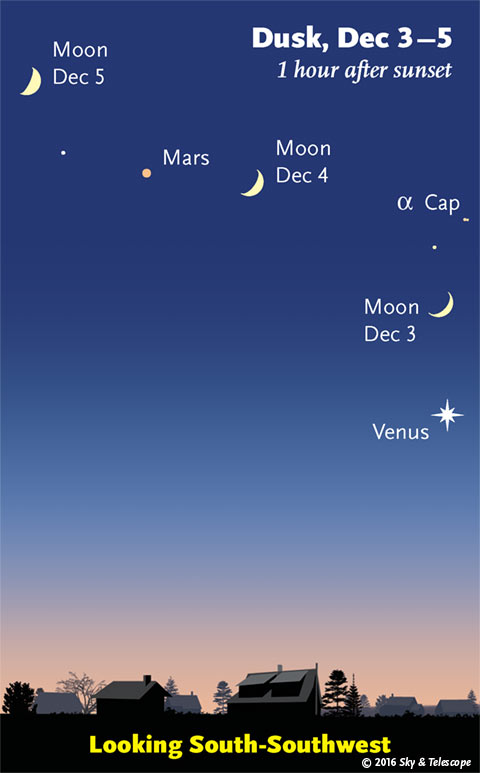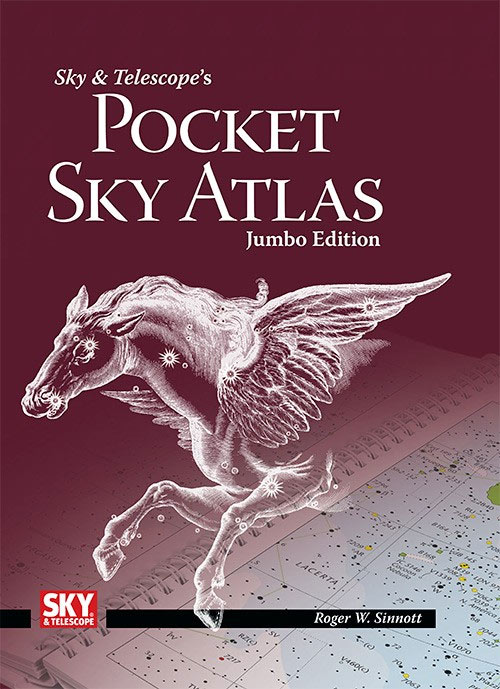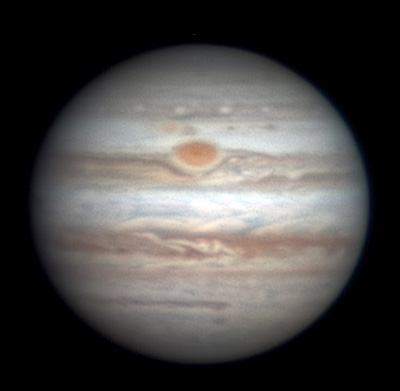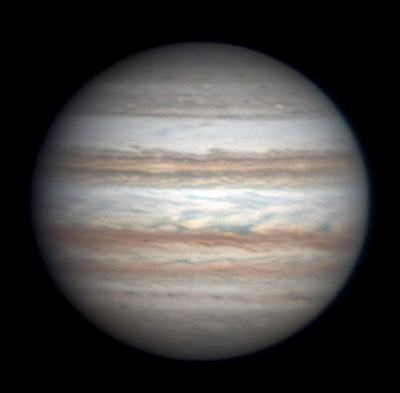
Friday, December 2
• For the next two evenings, the thickening crescent Moon poses with bright Venus in the southwest at dusk. This evening Venus and the Moon are 7° or 8° apart at the time of twilight for the Americas, with the Moon on the right, as shown here. Although they may look like they're keeping each other company, Venus is currently 370 times more distant than the Moon.
Saturday, December 3
• Now the Moon shines above Venus during and after dusk, as shown here. They're once again about 7° apart for the Americas.
Sunday, December 4
• The Moon shines about 5° or 6° to the right of little orange Mars in early evening, with Venus blazing far to their lower right. Farther to the Moon's lower left, you'll find twinkly Fomalhaut.
Monday, December 5
• At nightfall, look lower right of the Moon for Mars and much farther lower right from there for bright Venus. Meanwhile, well to the Moon's lower left is Fomalhaut.
Tuesday, December 6
• In late twilight, the Moon, Mars, and Venus form a long diagonal line in the south to southwest. Well below the Moon twinkles Fomalhaut.
Wednesday, December 7
• First-quarter Moon (exactly so at 4:03 a.m. on this date EST). After dark, look for the Great Square of Pegasus high above it.
• Earliest sunset of the year (if you're near latitude 40° north). By the time of the solstice and longest night on December 21st, the Sun actually sets 3 minutes later. But it doesn't rise its latest until January 4th. For these slight discrepancies, blame the tilt of Earth's axis and the ellipticity of Earth's orbit.
Thursday, December 8
• The left side of the Great Square of Pegasus points down past the gibbous Moon early this evening. Below the Moon is Beta Ceti (Deneb Kaitos, tail of the sea monster), about as bright as the stars of the Great Square.
Friday, December 9
• Vega still glitters brightly in the northwest early these evenings. Deneb is the brightest star above it. Deneb is the head of the big Northern Cross, which now extends to Deneb's lower left. By 10 or 11 p.m. the Northern Cross swings down and around to plant itself upright on the northwest horizon (as seen from mid-northern latitudes).
Saturday, December 10
• Right after dark you'll find the Pleiades well up in the east, with Aldebaran and the Hyades below them. Far below these, Orion is beginning to clear the horizon. By about 9 p.m. Orion is much higher and now Sirius is rising below it, completing this famous tall stack of December stars.
_________________________
Want to become a better astronomer? Learn your way around the constellations! They're the key to locating everything fainter and deeper to hunt with binoculars or a telescope.
This is an outdoor nature hobby. For an easy-to-use constellation guide covering the whole evening sky, use the big monthly map in the center of each issue of Sky & Telescope, the essential guide to astronomy.

Once you get a telescope, to put it to good use you'll need a detailed, large-scale sky atlas (set of charts). The basic standard is the Pocket Sky Atlas (in either the original or new Jumbo Edition), which shows stars to magnitude 7.6.
Next up is the larger and deeper Sky Atlas 2000.0, plotting stars to magnitude 8.5, nearly three times as many. The next up, once you know your way around, is the even larger Uranometria 2000.0 (stars to magnitude 9.75). And read how to use sky charts with a telescope.
You'll also want a good deep-sky guidebook, such as Sue French's Deep-Sky Wonders collection (which includes its own charts), Sky Atlas 2000.0 Companion by Strong and Sinnott, or the bigger Night Sky Observer's Guide by Kepple and Sanner.
Can a computerized telescope replace charts? Not for beginners, I don't think, and not on mounts and tripods that are less than top-quality mechanically (meaning heavy and expensive). And as Terence Dickinson and Alan Dyer say in their Backyard Astronomer's Guide, "A full appreciation of the universe cannot come without developing the skills to find things in the sky and understanding how the sky works. This knowledge comes only by spending time under the stars with star maps in hand."
This Week's Planet Roundup


Mercury (magnitude –0.5) is very deep in the bright afterglow of sunset, 20° or 25° to the lower right of Venus, as shown at the top of this page. Binoculars will help.
Venus (magnitude –4.2, crossing from Sagittarius into Capricornus) is the bright white "Evening Star" blazing in the southwest during and after twilight.
Mars (magnitude +0.6, in Capricornus) still glows in the south-southwest at dusk, 20° or 25° upper left of Venus. In a telescope it's a tiny orange blob only 6 arcseconds in diameter.
Jupiter (magnitude –1.8, in Virgo) rises around 2 or 3 a.m. and shines brightly in the southeast by early dawn. Look for Spica 7° or 8° under it at that time, and Arcturus 30° its upper left.
Saturn is lost in the sunset.
Uranus (magnitude 5.7, in Pisces) and Neptune (magnitude 7.9, in Aquarius) are high on the southern side of the sky just after dark. Info and finder charts.
__________________________
All descriptions that relate to your horizon — including the words up, down, right, and left — are written for the world's mid-northern latitudes. Descriptions that also depend on longitude (mainly Moon positions) are for North America.
Eastern Standard Time (EST) is Universal Time (UT, UTC, or GMT) minus 5 hours.
__________________________
"This adventure is made possible by generations of searchers strictly adhering to a simple set of rules. Test ideas by experiments and observations. Build on those ideas that pass the test. Reject the ones that fail. Follow the evidence wherever it leads, and question everything. Accept these terms, and the cosmos is yours."
— Neil deGrasse Tyson
 1
1








Comments
Anthony Barreiro
December 2, 2016 at 3:28 pm
This past week we've had some clear weather in San Francisco. I got up early a couple of times to observe Jupiter through a 70 mm f/6 refractor. At 93x magnification the asymmetry between the northern and southern hemispheres has been obvious. Christopher Go's photos help me to see what I was seeing.
You must be logged in to post a comment.
You must be logged in to post a comment.